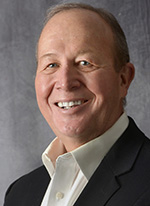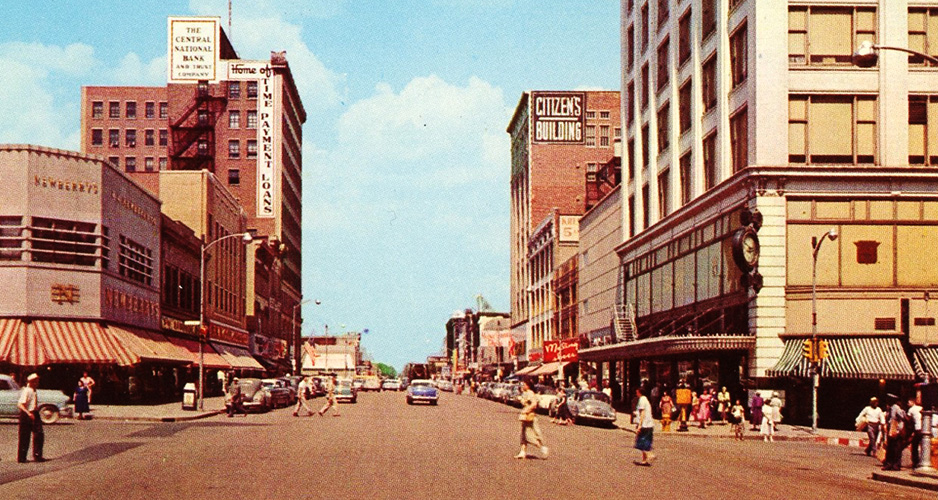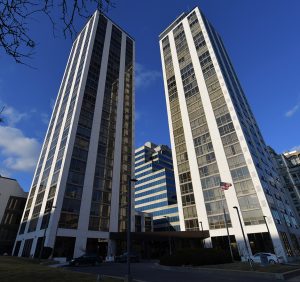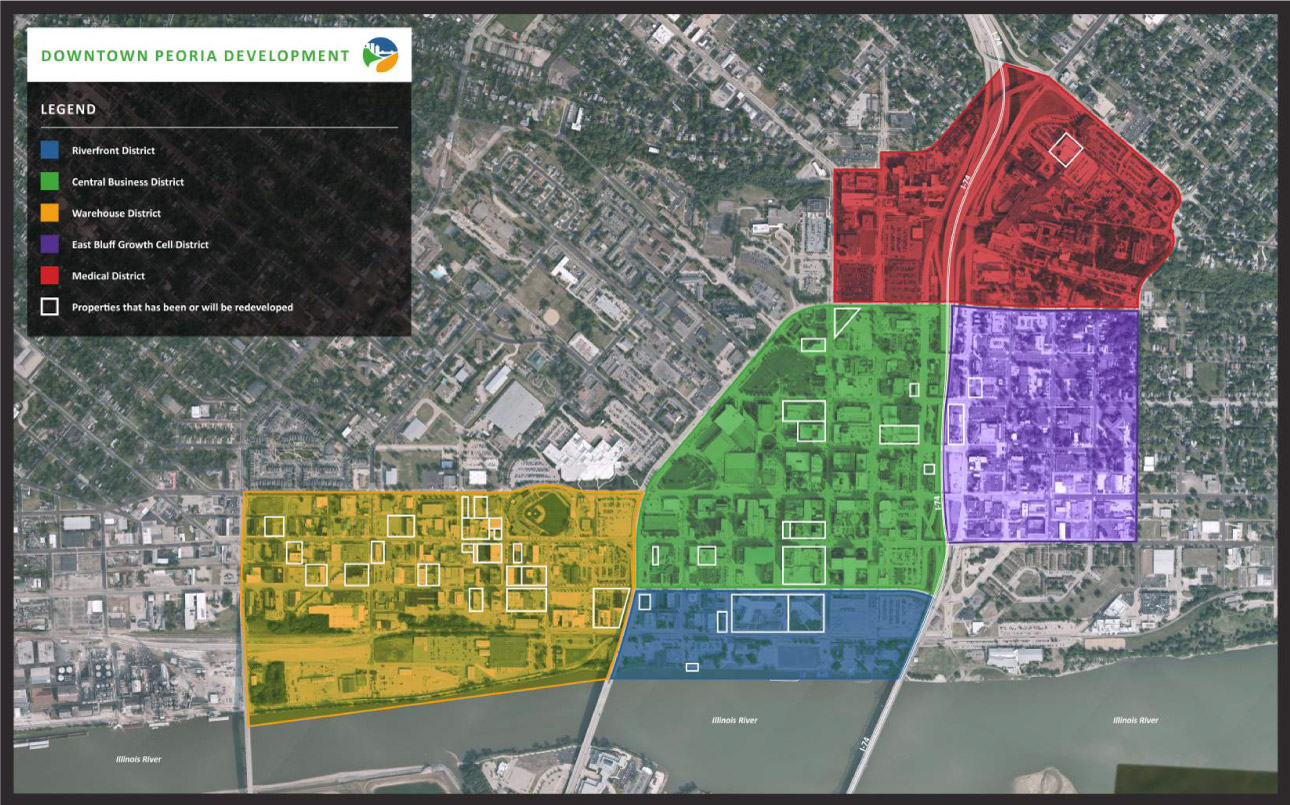We’ve done it before. Can we do it again?
“Downtown was the center of everything … The streets were thronged … People window-shopped along Main Street or lined up for the Saturday shows at the Madison, the Palace and the Rialto.”
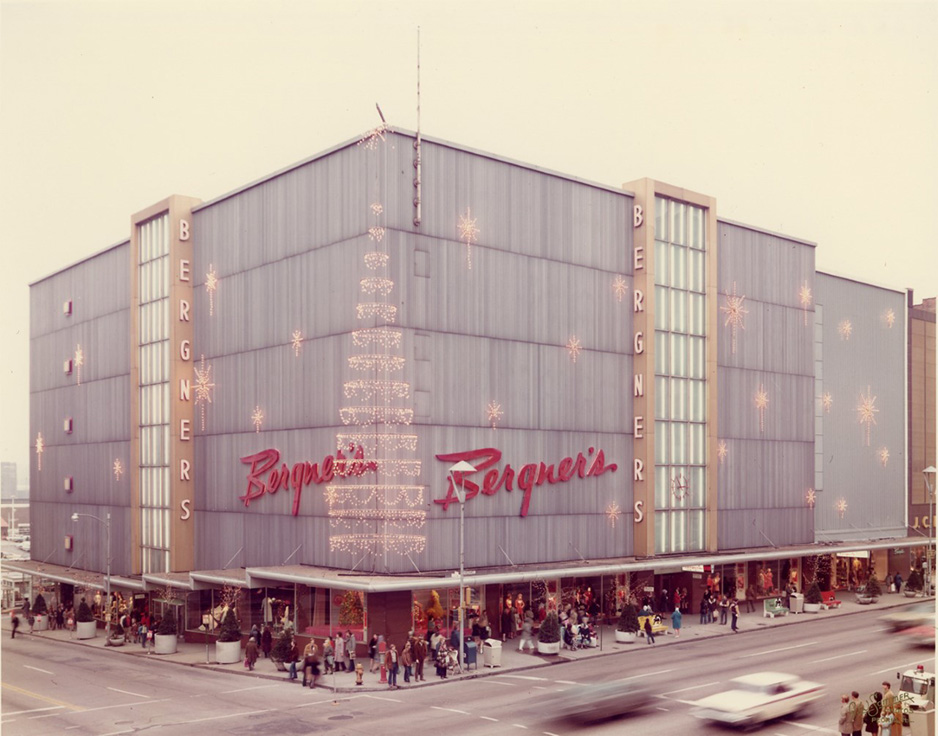
Those were the 1940s and ‘50s, Downtown Peoria’s heyday. But in seemingly the blink of an eye, “the vital downtown area began to grow old and change … No longer were there massive crowds downtown day and night. No longer did the changing of the lights at Fulton and Adams bring swarms of people surging between Block & Kuhl’s and Bergner’s. No longer were there massive downtown traffic jams. This became almost a ghost town, with empty and littered streets and crumbling pavement. It was threatened with a takeover by the kinds of peripheral businesses which thrive in areas at the point of collapse.”
Alas, Peoria was lucky, with “the labors and enterprises of forward-looking men and women … at its center.” They would regroup and reinvest. “Downtown has refused to die.”
So observed Jerry Klein, the longtime Peoria newspaper columnist and author of a definitive local history book, Peoria! He was writing from the perspective of 1985.
Almost 40 years have passed, and Downtown is at another hinge in its history.
Taking a deep dive
A lot of water has flowed under those Illinois River bridges in the ensuing decades. The 1950s and ‘60s saw construction of the Murray Baker Bridge and Caterpillar’s world headquarters Downtown. The 1970s and ‘80s witnessed the implementation of the Demetriou Plan, which envisioned the Civic Center and a renewed riverfront. The 1990s and early 2000s brought riverfront redevelopment. And firmly into a new century, Downtown leaders have turned their attentions to the Warehouse District and other reinventions, such as OSF HealthCare’s transformation of the historic Block & Kuhl building into its headquarters.
In short, Downtown has not suffered from insufficient investment. Add it all up and we dare say billions in public/private dollars have been spent in the last three decades. Since 2014, building permits totaling $300 million in estimated private investment have been issued in Downtown ZIP code 61602.
Yet, something still seems to be missing.
In fairness, COVID-19 emptied many a U.S. downtown, and office buildings have not returned to their previous occupancy levels in what might be a permanent shift in the American workplace. With Downtown hosting nearly 32,000 jobs pre-COVID — more than 40% of the city’s total workforce — the area had more to lose when remote work became a thing, though there has been perceptible bounce-back.
Nonetheless, there were signs of Downtown decline — barren sidewalks, sparsely populated parking lots, shop closings, decades-long vacancies, pop-up homeless villages, light traffic especially on weeknights and weekends — prior to 2020. What sparks there were didn’t seem to stay lit.
We explore why that is and what can be done about it in this issue of Peoria Magazine, with interviews of dozens of Downtown stakeholders — major employers, small business owners, residents, workers — who spoke to its advantages and disadvantages.
We heard more optimism than despair. While some chafed at the mention of Downtown being in need of any “rescue,” most acknowledged that the city center has seen livelier days. There was almost universal agreement that a visibly healthy, vibrant Downtown is critical not just to Peoria but to the region.
Here’s what we found.
First, ‘Downtown’ defined
Downtown Peoria stretches over nearly 600 acres bounded by the Illinois River and five distinct neighborhoods: the Central Business District incorporating the Main Street corridor, the Riverfront District, the Medical District including the two hospitals, the Warehouse District south to MacArthur Highway, and the Growth Cell District covering parts of the East Bluff and Near North Side.
Through many ups and downs over the years, Downtown still retains the region’s highest concentration of jobs (health care and manufacturing top the list), restaurants, bars, entertainment, sports and cultural venues from the Civic Center to Dozer Park to Peoria Riverfront Museum. It’s also a hub of banking, legal services, local government and the arts.
‘People need to return to the office’
“Every time I drive Downtown, I fall in love with it,” said Jane Scott of Jane’s Sweet Addictions, located in the former Nut House space on Main Street. “But I need foot traffic.” In conversations with scores of stakeholders, that was a consistent lament.
No recent count of how many people still go into work Downtown seems to exist, though local real estate brokers say a third or more of Downtown’s offices remain dark. If that’s so and the ratio holds to total employment, that would translate to thousands of workers missing in action Downtown. The mom-and-pop operators dependent on them believe their eyes and their cash registers.
‘Downtown has to be reimagined’— OSF HealthCare Vice President Ryan Spain
“You can certainly tell the in-person staffing is not back to what it once was,” said Craig Janssen, owner of Great Harvest Bread Co. inside the OSF headquarters building. “This hybrid schedule … it’s real. We have these wild swings. Monday and Friday, abysmal, but Tuesday through Thursday are really good.”
That’s because many employers are between a rock and a hard place, given the demand for skilled workers who now have the upper hand and want a work-from-home option.
“Any successful downtown is a 3-legged stool,” said Ryan Spain, vice president of economic development at OSF HealthCare and a state legislator. “You have to have a strong workday population. We used to have that. You need a strong visitor component. Before the pandemic … we were really building that. Where we’ve always been lacking … is on the final leg of the stool, which is residential.
“Downtown has to be reimagined.”
Apartments full, demand high
If office workers aren’t returning Downtown in full — “I don’t think it’s ever going to look like it did pre-pandemic,” said OSF CEO Bob Sehring — then by most accounts its salvation depends on more people living there.
Coming Downtown Investments
| Project | Location | Cost | Timeframe | Adams Street and Jefferson Avenue signal upgrade/one-way to two-way conversion between Walnut Street and Hamilton Boulevard | Central Business District | $15,970,000 | 2023–2025 |
|---|---|---|---|
| Sidewalk reconstruction | Central Business District | $10,440,000 | Undefined |
| Construction of Depot Street from Oak Street to Persimmon Street and new surface parking lot | Warehouse District | $10,166,000 | 2023 |
| Reopening Fulton Plaza to roadway traffic from SW Jefferson Avenue to SW Adams Street | Central Business District | $2,660,000 | Undefined |
| Main Street reconstruction from Water Street to Farmington Road | Central Business District | $51,750,000 | Undefined |
| Riverfront Park construction from the Murray Baker Bridge to the Bob Michel Bridge | Central Business District | $25,590,000 | Undefined |
| Street lighting upgrade on SW Washington Street from Hamilton to Fulton | Central Business District | $470,000 | Undefined |
| Washington Street improvements from Liberty to Fulton streets as part of Museum Block project | Central Business District | $3,785,000 | 2025-2026 |
Fifty years after architect Angelos Demetriou drew up plans to reshape Downtown while calling on more locals to make it their home, that has started to happen. Nearly 3,000 people live Downtown in some 1,500 units, which are just a tick short of being entirely full. Consultants say Downtown can easily handle 400 more units by 2026. Loft living is popular.
While there’s shelter Downtown for people of means, such as 401 Water and the Twin Towers, and for seniors and the poor, such as the 142-unit, $47 million Providence Pointe development the Peoria Housing Authority is building on the old Taft Homes site, more is needed for those in between. Worth noting is that while few dispute the need for housing at all income levels and life stages, according to a consultant’s report commissioned by the Downtown Development Corp., nearly 70% of Downtown households report annual earnings under $35,000.
Monthly rents in the Warehouse District, meanwhile, range between $750 for a studio to $2,100 for a two-bedroom, slightly less than the rest of the city. What’s lacking are the support services — a small market, drugstore, retail, etc.
“Those of us who live Downtown aren’t leaving because there’s no grocery store, but a grocery store is needed to attract more downtown residents,” said Julie Enzenberger, who resides in Twin Towers and works at Peoria’s Catholic Diocese.
To that point, “The suburban attributes of East Peoria and the urban benefits of Downtown Peoria” play well off one another and are “actually an asset,” argues John Morris, CEO and president of Peoria Riverfront Museum.
On everyone’s tongue: Parking
In some corners there’s not enough of it, in others visitors are reluctant to pay for it. Drive around too long looking for it and you may conclude Downtown isn’t worth the hassle.
Those views can run counter to the eyeball test, which reveals many far-from-full lots, garages and on-street spaces. Meanwhile, parking is expensive to build and maintain, often taxpayer-subsidized, unsightly and frequently unproductive regarding revenues generated. Beyond that, how many more hard surfaces are needed Downtown in a city that will have taxpayers shelling out upwards of $200 million to keep stormwater mixed with wastewater out of the Illinois River?
“Rather than all these meters, just have short-term parking,” advises restaurant owner Janssen, whose customers want “peace of mind that it’s OK to park and not get ticketed.”
Downtown attorney Stephen Morris concurs. “I’m looking out my window right now and there are four parking meters in front of me … There’s been nobody in them all day. If I were the City of Peoria, I’d rip every single meter out.”
It’s a boring subject but an important one where Downtown’s viability is concerned. There is a sense that parking can be done better — more strategically, attractively, productively, with less environmental downside.
Wanting ‘Walkable’
“Walkability” is the buzzword of the moment in urban planning circles, but at 600 acres, Downtown Peoria is not walkable for most. Who has a bite and a beer at Obed & Isaac’s and then strolls to Zion for a cup of joe?
Meanwhile, unless it’s a true destination like Kelly Seed or RC Outfitters, the draws may be too few and far between to make the trip Downtown worth someone’s while. Locally, Peoria Heights is probably the best example of a walkable downtown with bundled, proven attractions.
That said, are walkable pockets in distinctively branded, well-marketed Downtown neighborhoods with “more to do” in each possible? That’s taking shape in the Warehouse District with its “city within a city” vibe, but elsewhere, not so much. Downtown needs more after-5 p.m. activities to keep people around, say many.
It’s simple: “Business draws business,” said Pat Sullivan, at 72 one of the deans of the Downtown development scene.
Crime concerns
It’s not unusual to hear people say they’re “scared” of Downtown. But many, if not all, of those who spend the most time there say crime hasn’t been a part of their experience.
Statistics provided by Peoria Police seem to back that up. The crimes that evoke the most concern — burglary, armed robbery, aggravated battery, sexual assault, home invasion, homicide, etc. — are stable following a COVID dip, with total criminal activity in 2022 down more than 20% from 2018-19. Even as record-setting numbers of murders have plagued Peoria overall, not a one has been committed Downtown in those five years.
Nonetheless, when a 91-year-old man is the victim of a violent carjacking in a Downtown hospital parking garage, as occurred last December, it understandably causes unease. Even if it’s a rare occurrence, perception is reality for many, some will steer clear because of it, and city leaders must address it.
Anything that makes people feel more secure — brighter lighting, a uniformed police presence, etc. — helps. More shoes on the pavement provide their own protection.
Homelessness
To see the tent communities and the routine presence of people holding cardboard signs at intersections is to know that homelessness in central Illinois has grown. “Having great social services” may be one explanation for that increased presence Downtown, noted Sullivan.
Most folks want the unhoused to be treated with dignity and compassion but they also say the attendant issues — litter, makeshift bathrooms, sometimes-aggressive panhandling, etc. — can be a deterrent to visiting any downtown trying to roll out the welcome mat. Peoria isn’t alone; what’s working in other communities?
Downtown’s echo chamber
Frustration has grown with property owners who sit on vacant buildings or lots, in some cases for decades. The request? Please do something with those properties or do the community a favor and sell them to or partner with an entrepreneur who will.
Adam White, owner of RC Outfitters, is among those who feel like Downtown is being “held hostage … As long as those buildings are vacant, we are rowing upstream.”
“It’s a pretty substantial problem,” agreed Jim Mormann, OSF’s CEO of Integrated Solutions. In the first place, “it’s extremely costly” to restore a 100-year-old building. Second, “when owners want an arm and a leg for a building that’s decrepit, and you know what you have to put back into it … it becomes a daunting task.”
Historic tax credits have been a big help Downtown. Meanwhile, things may be looking up, as there are plans to raze one of those long-empty buildings, the former Sully’s Pub & Cafe, to make way for a $57 million hotel-residential development.
Appearances matter
“We don’t maintain the trees so they die,” said Sullivan. “Cut them down and it’s an ashtray.”
“On the RiverFront, all those dedicated bricks are falling apart. The fountain hasn’t worked for ages,” said Scott from her Main Street perch. “Even the Courthouse Plaza is falling apart.”
Joining that chorus was the museum’s Morris: “We need to act like we’re successful to be successful.” Pick up the garbage, plant a flower, water it, pull the weeds.
Other considerations
Downtown stakeholders have a lot to say.
When the Civic Center is hopping, they’re hopping. When it’s dark, they’re dark. That dependence is good and bad. “Right now, the Civic Center is killin’ it,” said Sean Kenny, owner of Kenny’s Westside Pub. “I hated losing March Madness and would hate to lose the Rivermen. The Bradley crowd is good for us.” When Keith Urban and comedian Bill Burr headlined a record-setting November weekend that brought more than 22,000 people through Civic Center turnstiles, “My God was it cool to be down here,” said Sullivan, who owns Kelleher’s Irish Pub.
In a Downtown where the one-way streets arguably were designed to get motorists in and out as quickly as possible, “I can’t wait for the two-way streets,” said Jack Berres, owner of Jack’s on Adams, voicing a popular sentiment. “It will give people a reason to slow down and take a look around at what’s here.”
Sometimes City Hall can be very helpful, as OSF’s leaders attest, and sometimes a business can wait months for a building permit when “time is money.”
“The answer to me is not more government, it’s less government,” said Steve Morris. “Find ways to make it easier to develop. Not more incentives, but just get out of the way.” Others point to taxes/fees in Peoria that are not always competitive with more bureaucratically “nimble” surrounding communities.
Finally, more programming, please, starting with bringing the food carts and music back to Courthouse Plaza. The St. Patrick’s Day Parade is a big boost of energy. The RiverFront Farmers Market on summer Saturday mornings feels like the Downtown should feel. “Somehow, we need to create the ‘porch’ for Downtown, the place life is done in communities,” said Andy King, executive director of Dream Center Peoria.
Think about it
A healthy Downtown Peoria with as many residents and jobs as it can hold is good for more than just the taxpayers who live and work there, argue some of its inhabitants.
Peoria has a 50-square-mile footprint for 113,000 people. Minneapolis’ 57 square miles are home to 425,000, San Francisco’s 47 square miles to 815,000, Manhattan’s 24 square miles to 1.6 million. Every time Peoria grows further into a cornfield, its taxpayers/ratepayers get the bill for sewer and water pipes, roads and sidewalks and street lights, police and fire protection. The costs are ongoing, the return on investment questionable.
Meanwhile, for Ardor Breads & Provisions owner Cody Scogin, Downtown represents the convenience of jumping on I-74 for his thrice-weekly pastry run to Rivian in Normal. “Business is good and I’m happy here,” and he’s expanding to boot.
For Venue Chisca/Heaven on Earth owner Michelle Spurgeon, it’s the incomparable history and architecture. “What I like about being down here is that these old buildings are being preserved … So many of them have been torn down … They just can’t build them like this anymore.” For others, the Sculpture Walk and colorful murals courtesy of Big Picture Initiative and others that have blossomed Downtown have very much brightened the predominantly brown-and-gray landscape.
For attorney C. Edwin Walker, it’s the scenery from his 17th floor office: “I’m not giving that up for anything.”
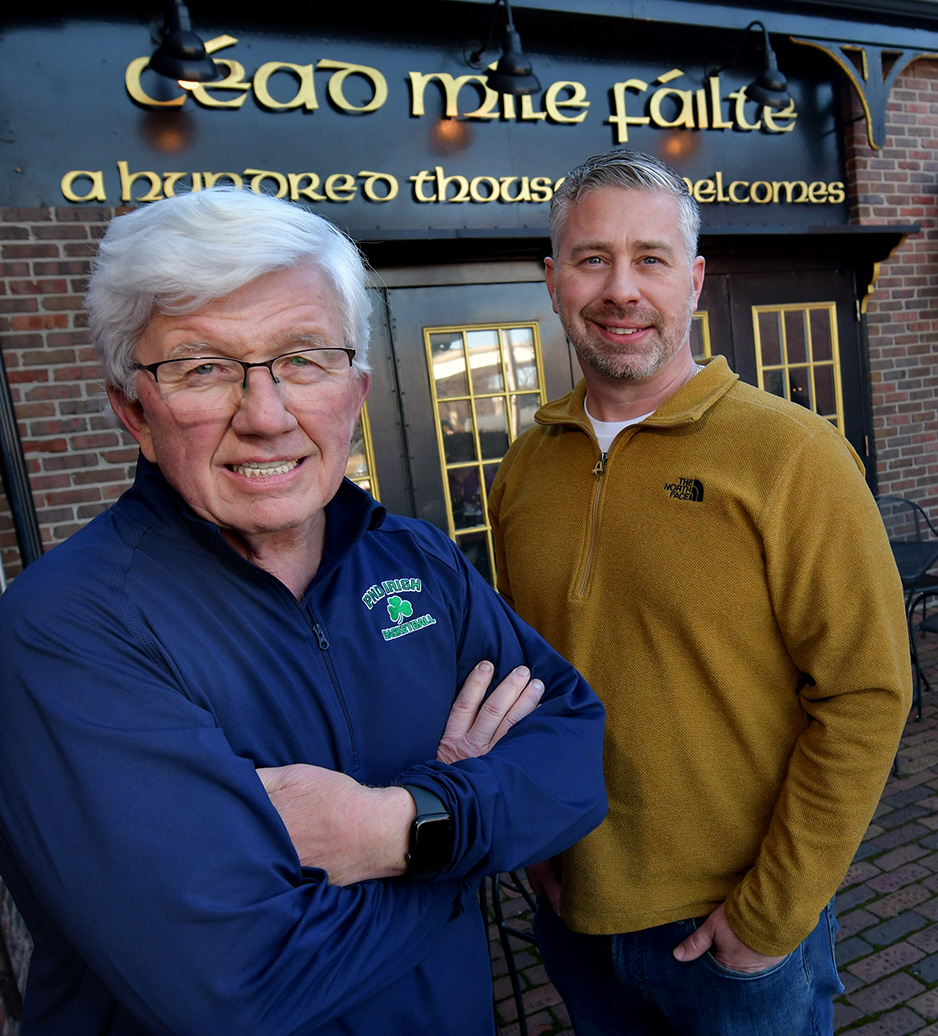
For Adam White, “coming Downtown was the right decision.” For Pat Sullivan, “the Downtown’s tried and true. Everything’s cyclical. It will come back. We want to be here when it does.” For John Morris, “I think we’re in a period of resurgence Downtown, not decline.”
Central Illinois brags many unique downtowns, but say the word “Downtown” hereabouts and everybody knows you’re referring to what Spain calls “the Mother Ship.” Google “Peoria area” and what comes up is that distinctive skyline. No matter where you live in this part of central Illinois, arguably you have a self-interest in a flourishing Downtown Peoria.
“Downtown is fundamentally the face of the region,” said Sehring, whose OSF has done so much to try to resurrect its fortunes. “A vibrant Downtown is critical to attracting investments, expanding employment opportunities, and recruiting highly skilled workers to the region. This is important to major employers … Growth helps real estate, supports services and improves the overall quality of our communities.
“In short, if downtown Peoria isn’t as successful as it can be, then greater central Illinois won’t be as successful as it can be, either.”
Peoria City Hall wants to hear from you! Email your feedback on making Downtown a livelier place to [email protected]
